Photo
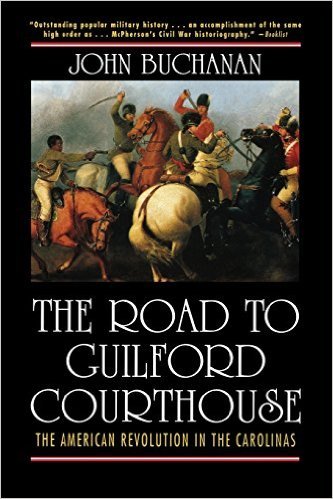
#DYK that General Benjamin Lincoln was narcoleptic?
Lincoln rode south to take up as difficult an assignment as given to any American general during the war. He was a man “about five feet nine inches in stature, and of so uncommonly a broad person, as to seem of less stature than he was”, for he weighed 224 pounds “and it sagged”. Fat, lumpy, lame to boot*, yet “with a countenance exceedingly kind and amiable” he also had an unfortunate affliction. “In the midst of a conversation, at table, and when driving himself in a chaise, he would fall into a sound sleep. While he command troops against the Massachusetts insurgents** he dictated dispatches and slept between the sentences. His sleep did not appear to disturb his perception of circumstances that were passing around him. He considered this an infirmity and his friends never considered to speak to him of it.
* Lame from being wounded in the Saratoga campaign. A musket ball shattered an ankle leaving him two inches shorter in that leg.
** These insurgents would be Western Massachusetts residents who were protesting in what would later be known as the Shays Rebellion
20 notes
·
View notes
Text
Tens of thousands of Charlevilles were shipped to America for use by the rebel forces during the American Revolution
Shooting my musket
Veteran Arms replica of a French Charleville Model 1763/66 flintlock musket.


Me with my friend who also did some shooting.

Grouping at 50 Yards. It shoots six inches high and six inches to the right. If I aim at the left corner I can keep a pretty consistent grouping near the bullseye. I was using 160 grains of Goex FF powder with a .66 caliber ball, no patch, firing with Goex FFFF powder in the pan.

Between the two of us we fired 25 rounds, both at paper and steel swivel targets. It hits consistently despite being a smoothbore without sights, firing an undersized ball without a patch. It only misfired once. Cleaning it afterward was a pain.
293 notes
·
View notes
Photo
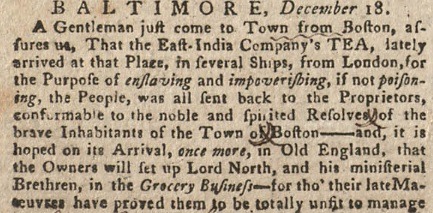

OTDIH, Jan 10, 1774 The Boton Gazette publishes a letter from Baltimore detailing what residents of that city had heard about the Tea Party. Included among this is the claim that 2,000 men were signed up to destroy the tea if needed.
This claim is quite baseless on the face of it, since a large number of participants were apprentices and such who joined the activities that night without being involved in the process beforehand.
OTOH, there were probably at least 2,000 in the crowd.
17 notes
·
View notes
Photo

OTD, Jan, 9, 1769 the Boston Gazette ran an advertisement from someone offering to give away a slave
6 notes
·
View notes
Text
The making of an 18th century British Army cartridge box
Source.
“One of the most enjoyable aspects of recreating the British Redcoat of the French and Indian War is the process of researching, designing and producing items of kit and equipment. After reading an excellent article published by the people at Fort Ticonderoga on replicating uniforms for their detachment of the 60th foot I thought it might be of interest to share the process behind the production of a replica British soldier’s cartridge pouch and strap. Hopefully this will help illustrate some of the effort that goes into building an accurate impression and may be helpful to anyone looking to embark on a similar project as well as providing an insight into some of the decisions and compromises that go into a historical reproduction.
Before getting into the design of this particular pouch it is worth looking briefly at the equivalents used by British troops earlier in the eighteenth century. One of the key historical sources of the period, ‘Representation of the cloathing of his majesty’s household’ of 1742 suggests that at the time of writing soldiers carried their ammunition in pouches of several different types, some entirely made of buff coloured leather, others with buff bodies and black flaps whilst others are all of black leather. Later sources such as the sketches of Paul Sandby and paintings of David Morier suggest that by the 1750s pouches were predominantly black. These illustrations also show a wide strap with three brass ‘double d’ buckles to allow for adjustment. Among these sources there seems to be a degree of variation in size and shape, this may be explained by the purchasing system of the period. Unlike today when military equipment is ordered in huge quantities for distribution throughout the service, in the eighteenth century much of a soldiers uniform and equipment was ordered by the commander of his regiment from local suppliers, often without a single government pattern to work from. This is reflected in the fact that surviving examples show significant variation whilst conforming to the same basic shape. Thus our starting point for this pouch was that it should be black leather with a buff leather strap using double d buckles.”

“The next step was to look at surviving examples of British cartridge pouches, there are a number of these with particularly good examples in the military museum in York. Unfortunately the odds of being able to get hold of this pouch to take measurements etc were pretty low. Another pouch that was particularly interesting is in the collection of noted artist Don Troiani, I was lucky enough to haveaccess to a set of measurements and schematics from somebody who was able to handle the pouch as well as a number of photographs and illustrations. Based on this I decided that the Troiani pouch would be the basis for this project but with a few modifications; the flap would need to be longer to reflect the pouch as it might have appeared before being trimmed down and I wanted to use a wider shoulder belt. This latter decision is, I’m afraid, a bit of a ‘reenactorism’ but is based on the fact that the original’s 2 ¾ inch strap seems fairly unusual and I wanted the final product to reflect the more common, wider, straps in the artwork of Sandby and Morier.”

“Construction of the pouch body was relatively simple, it is in three pieces (back, bottom/sides and front) with the back being slightly larger than the front. A small reenforcing panel sits at the bottom and protects the leather button. These were all dyed back and then stitched inside out before being turned so that the dyed side is outermost. From past experience I tend to think that it is best to start stitching pouches like this from the bottom centre and work towards the ends, this allows you to put the re-enforcing panel and button in the correct place and gives the best alignment of the three pieces. For the sake of simplicity all stitching was with neutral linen thread waxed with beeswax with a spacing of 5 stitches per inch (used for the body of the original).”
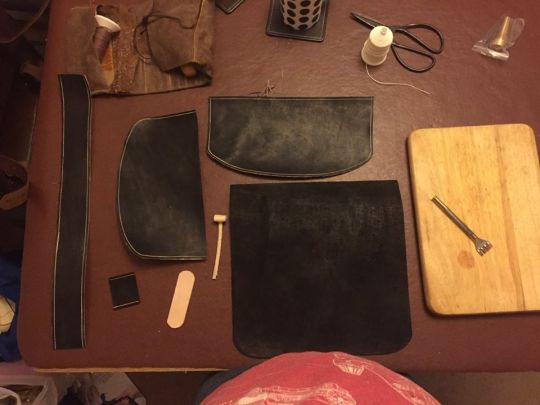

“The flap was then stitched to the back of the pouch with the two ends of the strap sandwiched between them. The strap ends are 4 inches long and were fitted so that each sits at an angle (20 degrees off perpendicular to the top of the pouch) to allow the pouch to hang better. The shoulder strap itself was made in two pieces to allow for adjustment. Once this was complete the whole pouch was treated with a 50/50 mix of beeswax and neatsfoot oil which softens and waterproofs the leather.”
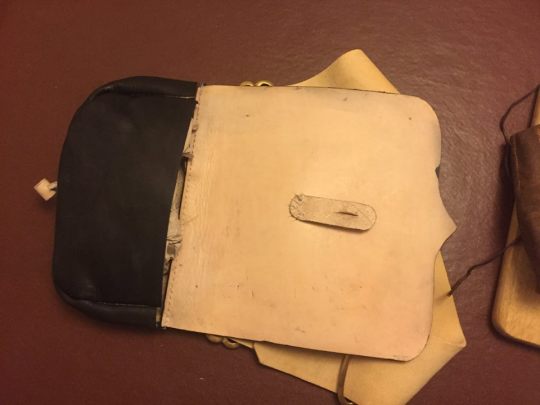
“The next step is to build the block for the inside; this was tricky as the instructions available were rather vague however I began by cutting a 11 x 2 x 3 ½ inch block and drilling out 21 holes of ¾ inch diameter in two rows. Drilling to a depth of 3 inches was challenging but the easiest method I found was to drill a small pilot hole, then follow by drilling to a depth of 2 ½ inches with a flat bit and then boring the last ½ inch with a forstner bit to create a smooth bottom. The block is a very tight fit and so the bag body was soaked with warm water to encourage it to stretch when the block was fitted. The block is held in place with 5 pairs of nails at the back and one pair on each side, the back nails also holding the small internal flap in place.”

“The next step is to build the block for the inside; this was tricky as the instructions available were rather vague however I began by cutting a 11 x 2 x 3 ½ inch block and drilling out 21 holes of ¾ inch diameter in two rows. Drilling to a depth of 3 inches was challenging but the easiest method I found was to drill a small pilot hole, then follow by drilling to a depth of 2 ½ inches with a flat bit and then boring the last ½ inch with a forstner bit to create a smooth bottom. The block is a very tight fit and so the bag body was soaked with warm water to encourage it to stretch when the block was fitted. The block is held in place with 5 pairs of nails at the back and one pair on each side, the back nails also holding the small internal flap in place.”
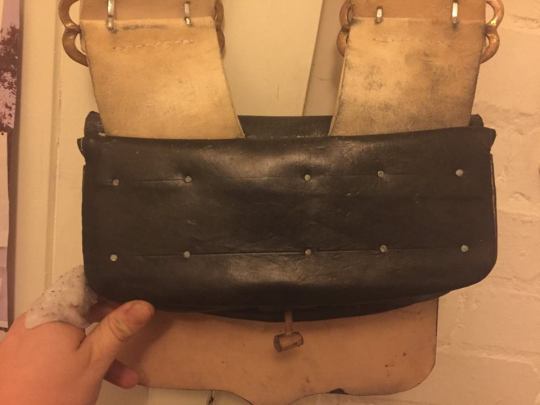
“Overall this was a very satisfying project however there are a number of areas to improve next time. I used the strap measurements from the original pouch which has produced a rather short strap (I am however a rather short person), I will probably look to replace the strap with a longer one at some point in the near future and would encourage others to do the same. My original measurements also suggested using a rectangle 2 inches by 18 inches for the side/bottom piece, normally I would have cut a longer piece and then trimmed it to size when the three pieces were stitched together, this time I trusted the instructions which meant that the piece was a little short which meant trimming the front of the bag by a few millimetres. I would also consider making the block slightly smaller to make it easier to fit to the bag.
The final product is a prototype of a pouch that fits with the period illustrations available and is a close (although not perfect) replica of an original pouch. There are a number of areas to improve on next time in terms of construction and quality of finish however this is a perfectly usable item that will be used by one of our members in the coming season. Thank you for reading, we welcome any comments and will be happy to answer any questions you may have. Special thanks go to Rick Seidemann of the 55th Regt, compy of Light Infantry. and to Mike Redgate of SJ SJ-Seamstress and Lace Wars for their advice and help during this project.”

93 notes
·
View notes
Photo
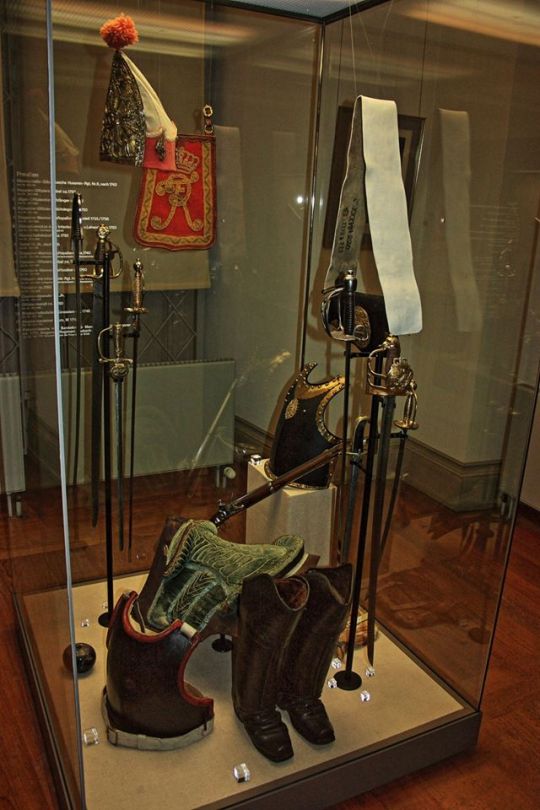
Weapons and equipment from the Seven Years War.
156 notes
·
View notes
Text
Strong work by @RoyalMail, who delivered this 1898 letter to Alfred Davis despite vague, albeit artistic addressing. pic.twitter.com/tM0HRVo1lU
— CentreBucksStudies (@CenBucksStudies) May 19, 2016
When I was a kid (many years ago) I used to be able to send letters to my grandmother in Wyoming addressed simply as "Minuteman's Grandma" and they would know who it was. Of course it helped that it was a small town and my grandmother was well known, but I don't think I could do that today, even though the town is still small and the family is still well known.
5 notes
·
View notes
Photo
Looks like they actually make jackets for larger gents too, something that’s all too rare.
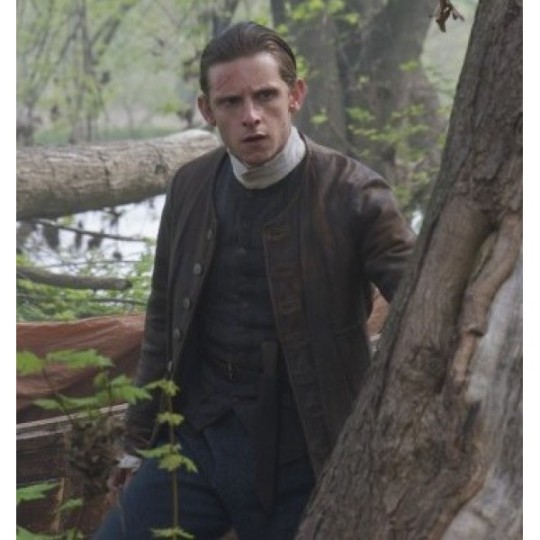
This site is selling a replica Jamie Bell jacket from AMC’s Turn. It’s ahistorical (why must producers on shows always bedeck their stars in leather?), but I must admit to having a certain weakness for both the leather jacket and the beanie he wears
59 notes
·
View notes
Photo

When Jefferson was ambassador to France (and even before that), he spent years trying to get a stuffed moose sent to France. It may seem a quixotic thing to us now, but it was arguably a matter of diplomatic importance in the late 18th century when Jefferson was attempting this (Jefferson finally got his moose sent over in 1787).
For more information I turn to this article A Moose More Precious Than You Can Imagine
In his massive encyclopedia of natural history, Histoire Naturelle, Buffon laid out what came to be called the theory of degeneracy. He argued that, as a result of living in a cold and wet climate, all species found in America were weak and feeble. What’s more, any species imported into America for economic reasons would soon succumb to its new environment and produce lines of puny, feeble offspring. America, Buffon told his readers, is a land of swamps, where life putrefies and rots. And all of this from the pen of the preeminent natural historian of his century.
There was no escaping the pernicious effects of the American environment—not even for Native Americans. They too were degenerate. For Buffon, Indians were stupid, lazy savages. In a particularly emasculating swipe, he suggested that the genitalia of Indian males were small and withered—degenerate—for the very same reason that the people were stupid and lazy.
Jefferson led a full-scale assault against Buffon’s theory of degeneracy to insure that these things wouldn’t happen. He devoted the largest section of the only book he ever wrote—Notes on the State of Virginia—to systematically debunking Buffon’s degeneracy theory, taking special pride in defending American Indians from such pernicious claims. The author of the Declaration of Independence employed more than his rhetorical skills in Notes. Jefferson produced table after table of data that he had compiled, supporting his contentions. Parts of Jefferson’s book were reprinted in dozens of newspapers across the United States in the 1780s.
Jefferson’s most concerted effort in terms of hands-on evidence was to procure a very large, dead, stuffed American moose—antlers and all—to hand Buffon personally, in effect saying “see.” This moose became a symbol for Jefferson—a symbol of the quashing of European arrogance in the form of degeneracy.
336 notes
·
View notes
Text
This is you should take any claims about scientific or historical discoveries with several grains of salt.
Lost Maya city? Or something else?
Making the rounds on the internet is a story about William Gadoury, a 15 year old boy from Quebec who claims to have found a lost Maya city in the jungles of Yucatan using a combination of constellation figures from the Codex Madrid and satellite imagery from Google Earth and other space agencies. While I applaud the boy’s interest in Maya archaeology and effort in helping to discover and identify settlements using remote sensing, I think we need take a step back and assess the claim of a lost city being discovered.
In these news articles Gadoury says he used Maya constellations from the Codex Madrid to create an overlay on the Yucatan peninsula to see whether or not sites lined up. He claims to have matched over 100 Maya cities to constellations, but in one of the constellation points is missing a site which he claims to have found through satellite imagery. What’s particularly lacking in these articles is Gadoury’s methodology. How does he determine the scale and orientation of the constellation overlays? Are all of the sites that match a constellation contemporaneous to one another? Does he reuse any of these sites for other constellations or is it a one and done situation? How does he know that one site was used just for that one constellation and not another? How does he suggest a group of competing kings from various city-states working together to build cities in accordance with these constellations? Where is the proof of this 86m high pyramid? And is he aware just how many Maya sites there are and how easy it would be to play with an overlay until sites lined up?
If we look to MayaMap.org we can see just how many Maya sites there are scattered around not only the Yucatan, but Belize, Guatemala, Honduras, and El Salvador.
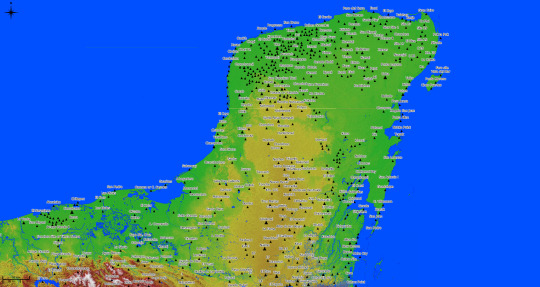
There are very many large and small sites. So it would be very easy to match sites up with constellations by changing the scale and orientation. And if we look at the map we can see that yes, there are gaps, but that doesn’t mean that the area is completely unknown and that there are lost cities waiting to be found.
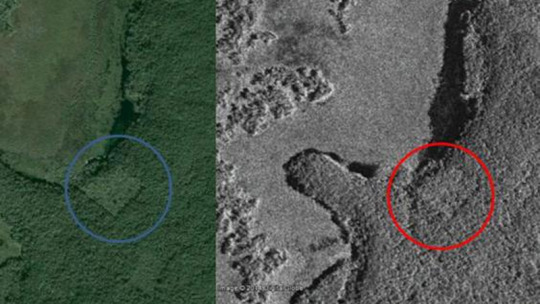
Based off the existing news articles showing the satellite imagery and a map showing the general location of this “lost” city, I’ve found that the location is on the shore of Laguna el Civalon. The square that is being touted as a structure looks very much like a cleared field for farming butting right up against the shore of the lake. Thomas Garrison, an anthropologist at USC Dornsife and an expert in remote sensing, also confirmed my assumption in this article by Gizmodo.
http://gizmodo.com/teen-discovers-lost-maya-city-using-ancient-star-maps-1775735999
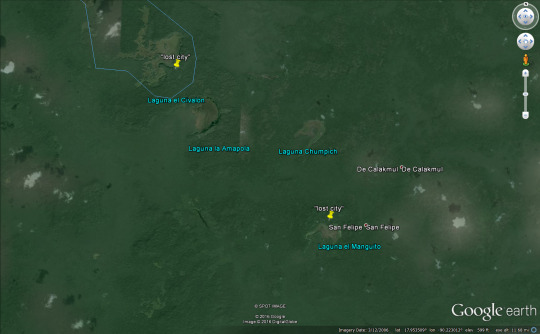
That being said, there are suspicious clusters of bumps in the satellite imagery which could be natural or artificial. Is this the “lost” city or is it something else?

Searching through Google Scholar has not produced any publication of archaeological work done in this area. However, what does come up are articles and books by Grant D. Jones, a historian who writes prolifically about the colonial Maya with a focus on the Itza Maya whose kingdom was conquered by the Spanish in 1697. In Jones’ work (1998) he mentions the site of Chunpich, a Kejach settlement east of Laguna el Civalon and Laguna Amapola. Chunpich consisted of three dispersed hamlets, but Jones makes little mention as to what the architecture or size of the hamlets was like. While these bumps may not be Chunpich, they may be a nearby settlements located on the other side of the shore that Jones believes must also have been inhabited.
What does this truly mean? Well, the Maya region was very densely populated. You would be hard pressed to go 10 meters and not run into something in the Lowlands. Even in northern Yucatan you are confronted with densely populated centers that spill out of their city walls as is the case of Mayapan.

Source - https://www.academia.edu/11395384/High-Density_LiDAR_Mapping_of_the_Ancient_City_of_Mayapan
It would be unsurprising if something was actually in the area. But does that mean there a lost city? Or an 86m high pyramid lurking in the jungle? Or that the Maya planned their cities according to constellations? Most likely that is a no. Cities and settlements were placed near resources that could be exploited like lacustrine or mineral resources. Cities were also placed near sources of fresh water so finding settlements near these lakes is really unsurprising. The other side of it is that it would be extremely difficult to get a group of competing kings from rival city-states and territories to band together to build cities according to constellations. This sort of overarching political structure is just not seen in the Maya region. David Stuart, a prominent Maya archaeologist who also made a comment in the Gizmodo article, has spent his entire career fighting against the notion that the Maya were a stargazing society that used the stars to guide their every action. So planning multiple cities to form a constellation on the ground just doesn’t add up.
The saddest part of this whole incident is what is going to happen to William Gadoury. He’s obviously enthusiastic on learning about the Maya and bringing new ideas to the table. It’s just unfortunate that a Maya expert wasn’t consulted before the media decided to exploit this poor boy for a junk science article to get ratings and clicks. Even an expert on remote sensing could have told Gadoury that the square featured in all of these articles was a field and avoided this whole mess. It is my hope that Gadoury isn’t discouraged that his claim doesn’t hold up and instead redoubles his efforts as he hopefully finishes high school and goes on to university. Unfortunately academia can be harsh when presented with extraordinary claims lacking extraordinary evidence.
103 notes
·
View notes
Photo

OTDIH, May 10 1773 the Tea Act was passed. Resistance to the Tea Act would eventually lead to the start of the American Revolution. Read the Boston Gazette and Country Journal for May 10, 1773 here.
Also OTDIH:
1756: The House of Burgesses hires 4 ships to transport Acadian deportees from Virginia to Britain (The governor of Virginia was worried that the Acadians would conspire with slaves and Indians in the French & Indian War)
1756: Sir William Johnson nearly loses his life to friendly fire

1775 – Representatives from the 13 Colonies begin the 2nd Continental Congress
1775 Alexander Hamilton prevented a mob from lynching King's College President Myles Cooper.
1780: Lafayette arrives at winter headquarters in Morristown
37 notes
·
View notes
Link
Robert Carl Keyes continues the Adverts 250 Project. Today’s colonial advertisement is an ad placed in The Virginia Gazette for help locating and returning a runaway slave.
2 notes
·
View notes
Link
We tend to think that the Revolutionary War ended with the surrender of British forces at Yorktown. However there would be another two years before peace was signed, and during that time there was a lot of action going on, particularly in battleground states like New Jersey, New York, and various places in the South.
In fact, I have a Loyalist ancestor who was killed in New Jersey by Whig militias in 1782.
18 notes
·
View notes
Link
Excellent article on a little known episode from the American Revolution. The Massachusetts Spy was one of the most radical papers in New England. At one point before the war the editor of the Spy was charged with libel because he challenged the right of the governor of MA to govern. The grand jury refused to indict him. On that grand jury were several men who would become leading Patriots--some of whom would end up participating in the Boston Tea Party.
33 notes
·
View notes
Link
In colonial America, "the very style in which one formed letters was determined by one's place in society," writes historian Tamara Thornton in Handwriting in America: A Cultural History. Thanks to the rigorous teachings of professionals called "penmen," merchants wrote strong, loopy logbooks, women's words were intricate and shaded, and upper-class men did whatever they felt like. So different were the results, says Thornton, that "a fully literate stranger could evaluate the social significance of a letter… simply by noting what hand it had been written in."
229 notes
·
View notes
Text
TURN Season 3: All Quiet on the History Front?
New post + link roundup! #TURNamc Season 3: Dude, where’s my history?

Greetings, TURNcoats! How about a nice link roundup to compliment the first two episodes of Season 3? Here we are, technically 1/5 of the way into Season 3, and things have been suspiciously quiet over here at the blog. Sure, we’ve had a blast live-tweeting every episode, but no new articles here at the blog. What gives? The waiting is the hardest part. Well, to be honest, there hasn’t been a…
View On WordPress
9 notes
·
View notes
Text
UCI’s Own Miniature Mondays

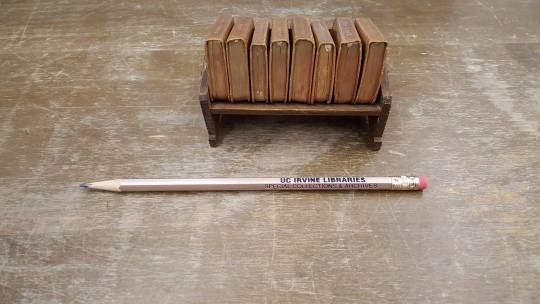


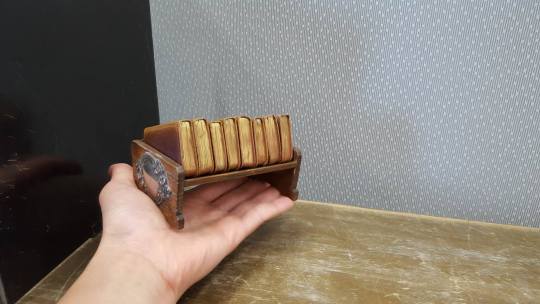

[Miniatures][Shakespeare] A set of eight Shakespeare plays in matching volumes in a special decorated wood case. Cover size is 5.2 cm or 2 1/8 inches. Glasglow: David Bryce, 1904. The plays are a mix of histories, comedies, and tragedies
320 notes
·
View notes